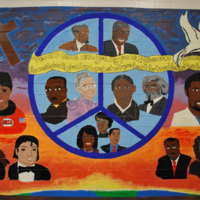
Saint Sabina Mural
In 2011, Chicago-based muralist Lavernon Spivey painted a mural with Howard University students at the Saint Sabina Catholic Church in Chicago’s southside. The mural depicts African American heroes both local and national, past and present, including the antislavery figures Frederick Douglass Harriet Tubman, and also Mae C. Jemison, Barack Obama, Harold Washington, Martin Luther King Jr., Michael Jackson, Michelle Obama, Rosa Parks and Shirley Chisholm. The mural also includes a passage form John 14:27 that reads, “Peace I leave with you, my peace I give unto you not as the world giveth, give I unto you, let not your heart be troubled, neither let it be afraid.”
![Nelson Stevens, Centennial Vision, Tuskegee University Administration Building, AL, 1980 [destroyed].jpg.gif Nelson Stevens, Centennial Vision, Tuskegee University Administration Building, AL, 1980 [destroyed].jpg.gif](https://486312.frmmmguz.asia/files/square_thumbnails/1a0ef8af8ec25559e5c2c7c66502ba40.jpg)
Centennial Vision
In 1980, on the anniversary of the founding of the Tuskegee Institute, AfriCOBRA member Nelson Stevens created a mural to celebrate the occasion. Although Stevens was commonly an exterior mural painter, he created this mural on the inside of the Tuskegee University Administration Building. The mural contains the images of black history figures such as Booker T. Washington (former president of Tuskegee University), General Chappie James and the Tuskegee airmen of World War II, Cinque, Malcolm X, Martin Luther King Jr., and George Washington Carver, as well as the antislavery figures Harriet Tubman, Sojourner Truth and Frederick Douglass. Also included in the image is a phrase made famous by the African scholar John S. Mbiti, “I Am Because We Are.” This mural no longer exists.
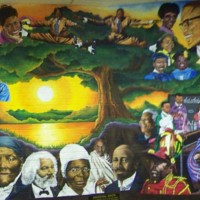
Ancestral Roots
Pontella Mason is one of Baltimore’s unsung visual artists. He has created murals for the Anacostia Community Museum, former President Jimmy Carter, and several other public organisations. His murals depict African American life and the diaspora. In 1999, he created the extensive mural Ancestral Roots, which depicts the antislavery heroes Harriet Tubman, Sojourner Truth, and Frederick Douglass, as well as Martin Luther King Jr., Malcolm X, Muhammad Ali, Notorious B.I.G., Tupac, Shirley Chisholm, and Marcus Garvey.
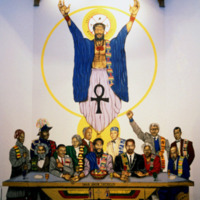
Last Supper
In 1990, muralist Maurice Myron Jenkins created an alternative version of Leonardo da Vinci’s 1494 fresco The Last Supper. The 30 by 19 foot mural depicts the last supper with a black Christ and 12 historical black figures as the prophets. Jenkins chose the Union Temple Baptist Church in Anacostia, Washington D.C. as his canvas because of its role in black history all the way back to its affiliation with Anacostia-resident Frederick Douglass in the 19th century.The mural includes the antislavery figures of Sojourner Truth and Frederick Douglass, as well as Marcus Garvey, Martin Luther King Jr., Rosa Parks, Elijah Muhammad, Malcolm X, Mary McLeod Bethune, Nelson Mandela, Booker T. Washington and W.E.B. Du Bois.
![Diego Rivera, Panel V of Portrait of America, New Workers School, New York City, 1933 [destroyed] (2).jpg Diego Rivera, Panel V of Portrait of America, New Workers School, New York City, 1933 [destroyed] (2).jpg](https://486312.frmmmguz.asia/files/square_thumbnails/5a3ba3415ccc36fadeb19c4d16fa1879.jpg)
Portrait of America
In 1933, the Mexican muralist Diego Rivera painted a 21-panel mural titled Portraits of America. Created for New York City’s New Workers School, the mural focused on issues of racial inequality and depicted the antislavery figures Frederick Douglass and John Brown, as well as shackled slaves - seen here in panel five of the mural. Rivera believed art was a weapon in the class struggle and frequently produced murals about revolution. Rivera, David Alfaro Siqueiros and José Clemente Orozco were the pioneers of the Mexican mural movement, and influenced mid-century African American muralists Hale Woodruff, John Biggers and Charles White.
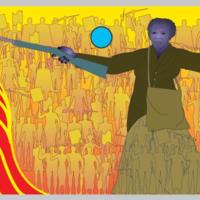
The Dreams of Harriet Tubman
In 2000, muralist Mike Alewitz planned on creating a series of murals about the heroes of the abolitionist movement, titled The Dreams of Harriet Tubman. Alewitz’s goal was to have the Dreams series as a necklace of murals across the state of Maryland with the flagship mural on a major wall in the city of Baltimore. This mural would depict Harriet Tubman, who was also known as Moses. In a pre-circulated plan on Black Radical Congress General News, Alewitz described how the flagship mural would have an army of freedom fighters (Martin Luther King Jr., Malcolm X, Mumia Abu Jamal, Sojourner Truth and Robert Gould) standing behind a musket-wielding Tubman. But the mural stirred up controversy when the group who had planned to display the mural, the Associated Black Charities Inc., decided the piece could be construed as racist and violent. Alewitz was asked to replace the musket but he refused: “I will not disarm Harriet Tubman. I won’t take [the musket] out of her hands.” The lack of a major wall was a setback for the Dreams series and another of the murals, on a wall in Hartford County, was defaced in the summer of 2000 by racist graffiti.
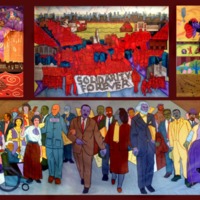
The City at the Crossroads of History
In 2011, the Puffin Foundation commissioned Mike Alewitz to paint a mural for the Puffin Gallery of Social Activism that would be on display in the Museum of the City of New York. Completed in 2014, the mural is a tribute to the labour and social justice movements and contains four panels. It includes slave ships and depicts the antislavery leader Frederick Douglass, as well as Martin Luther King Jr., Coretta Scott King and Elizabeth Gurley Flynn.However after viewing the mural, the museum declined to display it. They requested changes that reduced the prominence of Martin Luther King Jr. and added the Women’s Christian Temperance Union. Alewitz calls this a case of censorship and continues to campaign for his mural to be displayed.
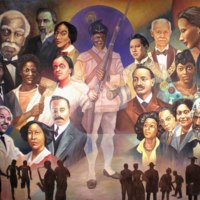
The Shoulders of Heroes We Lean On
This mural was created in 2012 by Munir D. Mohammad for the Rhode Island Black Heritage Society, one of the oldest African heritage organisations in the country. Titled The Shoulders of Heroes We Lean On, the mural depicts giants of black history, including the antislavery leader Frederick Douglass, as well as the silhouettes of athletes, musicians and scholars.
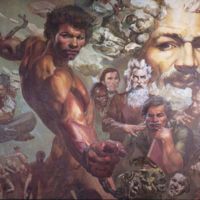
Life and Times of Frederick Douglass
In 1972, artist LeRoy Foster created this mural for the Douglass Branch of the Detroit Public Library. The mural depicts a meeting between Frederick Douglass and John Brown that took place on March 12, 1859, seven months before Brown’s raid on Harper’s Ferry. The mural contains three likenesses of Douglass in various stages of his life – the most prominent being the shirtless figure in the centre of the mural. The second largest figure of Douglass portrays him with the leonine, statesmen persona that he embodied later in his life. Finally, the smallest Douglass likeness is the seated figure speaking with John Brown. This small scene marks a pivotal moment in Douglass' life. In 1859 he had to make the decision between fighting with Brown (embodying the chain-breaking version of himself in the mural), or surviving to become a political leader. Choosing not to take up arms at Harper's Ferry, an attack that led to the execution of Brown for treason, Douglass chose the elder statesman person - and lived to 1895.
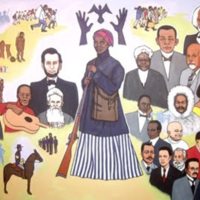
From Africa to America
Wilfred R. Stroud created this seven-panel mural in 1988 to be installed on the first floor of the Tubman Museum. It remains a signature piece in the Museum’s collection today. When the mural was being created, Stroud expained: “The purpose of this mural is to present a visual history of the black man and woman from the earliest times in Africa to the present times in America. The panels focus attention upon the impact of outstanding persons, and events that made a change in the lives and conditions of black people in particular, and the world in general.” Stroud dedicated an entire panel to the topic of slavery. Harriet Tubman stands in the centre, holding a rifle and surrounded by other antislavery leaders: Sojourner Truth, Abraham Lincoln, Frederick Douglass and John Brown.
![Cletus Alexander, Frederick Douglass Inspiring the Youth of the Negro Race, MacFarlane Middle School, Dayton, OH, 1933 [now in Dayton Art Institute] (2).jpg Cletus Alexander, Frederick Douglass Inspiring the Youth of the Negro Race, MacFarlane Middle School, Dayton, OH, 1933 [now in Dayton Art Institute] (2).jpg](https://486312.frmmmguz.asia/files/square_thumbnails/25a4cf3110ae30cf50088118e9193e7b.jpg)
Frederick Douglass Inspiring the Youth of the Negro Race
In 1933, Cletus Alexander, a student at Dayton Art Institute, submitted designs for a mural titled Frederick Douglass Inspiring the Youth of the Negro Race. Douglass is depicted as a biblical, Moses-like figure with flowing hair and a white beard, wearing traditional red and white robes. Towards the top of the mural are the words from Langston Hughes’ poem, Youth: “We have to-morrow, Bright before us, Like a flame, yesterday a night-gone thing, A sundown name, And dawn today, Broad arch above the road we came, we March!” At the time the mural was painted, it was housed in the MacFarlane Middle School building. After that building was destroyed in 2005, it was removed, restored, and is housed in the Dayton Art Institute.
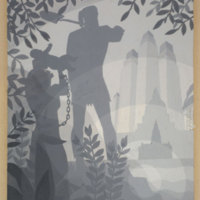
The Founding of Chicago
In 1933, Aaron Douglas created a mural titled The Founding of Chicago. The mural depicts the role of slaves and free African Americans in the creation of American cities across the country. Standing in the centre of the mural, the Haitian founder of Chicago, Jean-Baptiste Pointe du Sable, surveys the urban environment he helped to construct. Behind du Sable, a shackled woman raises her child to view the towering metropolis. Today the mural is housed at the Spencer Museum of Art, at the University of Kansas.
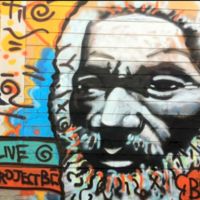
#projectbe / Exhibit BE
Brandan Odums’ murals are unusual because they tend to be off-limits to the public. One of the few muralists to reclaim dilapidated and abandoned building spaces as canvasses after Hurricane Katrina, Odums created a series of graffiti murals that aimed to inspire and provoke audiences. Although conscious of legal repercussions, Odums believed he had “a responsibility to influence people. If I see there’s a problem with a property that’s been sitting there for eight years, then I’m going to solve it within my own brain.” Turning a site of neglect into a site of pride, Odums used the Florida Housing Development in the Ninth Ward as his canvas for #projectbe, filling it wall-to-wall with portraits and quotations from figures that include the antislavery leader Frederick Douglass, Huey P. Newton, Nina Simone and James Baldwin. His artwork was deemed illegal due to his trespassing on private property. It was only seen in person by handful of visitors. After #projectbe ended, Odums embarked on a larger project at Degaulle Manor – a 360-unit apartment block. After speaking with the owner of the property, Odums was granted permission to temporarily use the building and invite the public. This project was called Exhibit BE. Around 35 street artists assisted and turned the abandoned building into one of the largest street exhibitions in the south, with 30,000 people visiting Exhibit BE in three months. The second mural of Douglass is from this exhibition.
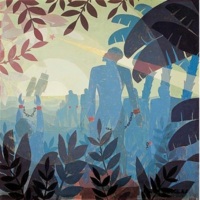
Into Bondage
In spring 1936, as part of the “healing process of the nation” during the aftermath of the Great Depression, President Franklin D. Roosevelt approved the Texas Centennial Exposition in Dallas. Although African Americans took part in the exhibition, their designated section of the fair was in the Hall of Negro Life; a separate building isolated from the main path by a row of cedar trees and shrubs. One of the murals on show was Aaron Douglas’s Into Bondage. Douglas’ murals gave African Americans a new identity at the Exposition by drawing on a usable antislavery past to develop an alternative narrative of black history: no longer passive enslaved supplicants, African Americans are empowered liberators. Douglas layered the mural with a guide for potential resistance.
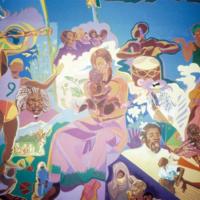
Races of the Student Population
In 1976, the Mexican muralist Manuel Martinez created a mural at Auraria College titled Races of the Student Population. It depicts the antislavery leader Frederick Douglass alongside figures of the Black Power Movement including Bobby Seale, and figures and symbols of the African diaspora.
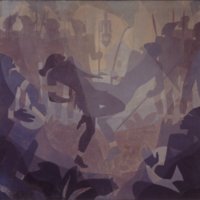
Aspects of Negro Life
Two years prior to the Texas Centennial Exposition, Aaron Douglas created a four-part mural series titled Aspects of Negro Life, to be housed in the 135th Street branch of the New York Public Library, the Schomburg Center. The various panels portray black history from slavery through to present. The various panels are titled, The Negro in an African Setting, From Slavery Through Reconstruction, Song of the Towers, and An Idyll of the Deep South, and depict the breaking of chains, the idea of self-emancipation, liberation, and the celebration of African culture.
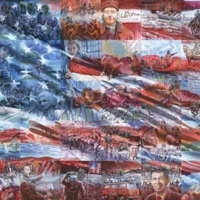
E Pluribus Unum
E Pluribus Unum, “Out of Many, One,” was a mural created by Lewis Lavoie in 2012. Described as a snapshot of America, the mural brings together 50 different stories from American history, celebrating a diverse past. Located in South Jordan City’s central City Hall building, the mural is a collage of narratives such as ‘The Abolitionist Movement,’ ‘the Civil War,’ ‘The Creation of the New Media’ and ‘Westward Expansion’ for example.
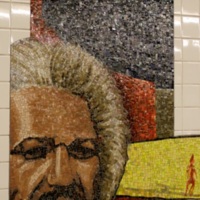
Migrations
In 1999, artist Christopher Wynter created a mosaic installation at the Cathedral Parkway subway station in Harlem. He explained that the 3-part mosaic series titled Migrations “present the ideas of uprooting, migration, and progress in symbolic form." The installation features Frederick Douglass and was placed in the subway station that runs underneath Frederick Douglass Boulevard.
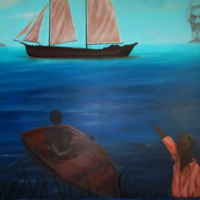
Underground Railroad
In 2012, Mexican muralist Luis Zarate created the mural Underground Railroad on Bay Street in Sodus Point, Wayne County in upstate New York. Sponsored by the Neighborhood Association of Sodus Point, the mural depicts the involvement of Sodus Point in the Underground Railroad of the 1850s. Captain George Garlock, who captained the ship Free Trader out of Sodus Point and picked up runaway slaves on his way to Canada, is depicted in the centre of the mural on the boat between the black antislavery leaders Harriet Tubman and Frederick Douglass. On July 14, 2012, a dedication ceremony revealed a plaque was mounted below the mural that reads: “This mural depicts a scene of the Underground Railroad. From stories passed down there were several safe houses in this area that were used to harbor 'Freedom Seekers.' These included the old Cohn Farm and the old Sodus Fruit Farm and what is now Maxwell Creek B & B and Silver Waters B & B. Sometimes a schooner, out of the old Sodus Point ore dock, would pick up slaves on its way to Canada."
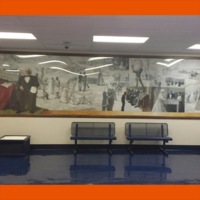
Douglass High School Mural
In 1990, an unnamed artist completed a mural inside Douglass High School in Baltimore. The mural was in a corridor and depicted black and white scenes of slavery in the background, and a colour version of the abolitionist Frederick Douglass in the foreground.